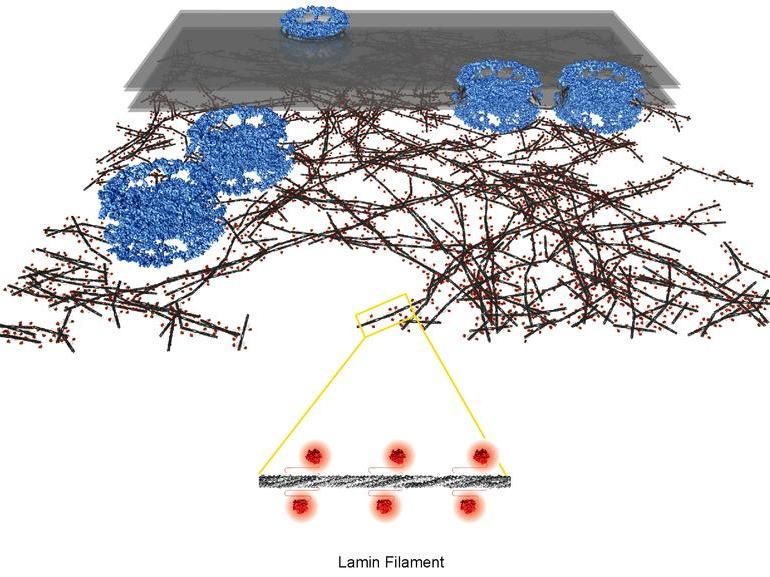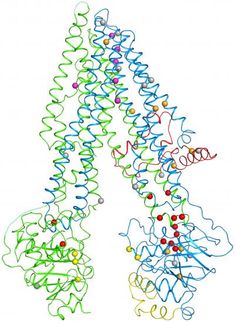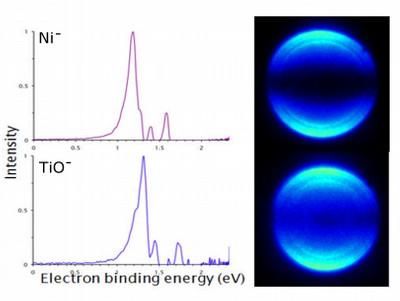Molecular structure of the cell nucleoskeleton revealed for the first time
Using 3D electron microscopy, structural biologists from the University of Zurich succeeded in elucidating the architecture of the lamina of the cell nucleus at molecular resolution for the first time. This scaffold stabilizes the cell nucleus in higher eukaryotes and is involved in organizing, activating and duplicating the genetic material. Diseases such as muscular dystrophy and premature aging, caused by mutations in the lamin gene, the major constituent of the lamina, can now be studied more effectively.

Nuclear lamina: architecture of delicate meshwork made of lamin filaments (filament rod in dark grey, globular domains in red) beneath nuclear membrane (transparent grey) and pore complexes (blue).
Yagmur Turgay, Universität Zürich
Compared to bacteria, in eukaryotes the genetic material is located in the cell nucleus. Its outer shell consists of the nuclear membrane with numerous nuclear pores. Molecules are transported into or out of the cell nucleus via these pores. Beneath the membrane lies the nuclear lamina, a threadlike meshwork merely a few millionths of a millimeter thick. This stabilizes the cell nucleus and protects the DNA underneath from external influences. Moreover, the lamina plays a key role in essential processes in the cell nucleus – such as the organization of the chromosomes, gene activity and the duplication of genetic material before cell division.
Detailed 3D image of the nuclear lamina in its native environment
Now, for the first time, a team of researchers headed by cell biology professor Ohad Medalia from the Department of Biochemistry at UZH has succeeded in elucidating the molecular architecture of the nuclear lamina in mammalian cells in detail. The scientists studied fibroblast cells of mice using cryo-electron tomography. “This technique combines electron microscopy and tomography, and enables cell structures to be displayed in 3D in a quasi-natural state,” explains Yagmur Turgay, the first author of the study. The cells are shock-frozen in liquid ethane at minus 190 degrees without being pretreated with harmful chemicals, thereby preserving the cell structures in their original state.
“The lamin meshwork is a layer that’s around 14 nanometers thick, located directly beneath the pore complexes of the nuclear membrane and consists of regions that are packed more or less densely,” says Yagmur Turgay, describing the architecture of the nucleoskeleton. The scaffold is made of thin, threadlike structures that differ in length – the lamin filaments. Only 3.5 nanometers thick, the lamin filaments are much thinner and more delicate than the structures forming the cytoskeleton outside the cell nucleus in higher organisms.
New approach for research on progeria and muscular dystrophy
The building blocks of the filaments are two proteins – type A and B lamin proteins – which assemble into polymers. They consist of a long stem and a globular domain, much like a pin with a head. Individual mutations in the lamin gene elicit severe diseases with symptoms such as premature aging (progeria), muscle wasting (muscular dystrophy), lipodystrophy and damage of the nervous system (neuropathies). “Cryo-electron tomography will enable us to study the structural differences in the nuclear lamina in healthy people and in patients with mutations in the lamin gene in detail in the future,” concludes Ohad Medalia. According to the structural biologist, this method permits the development of new disease models at molecular level, which paves the way for new therapeutic interventions.
Original publication
Most read news
Other news from the department science
These products might interest you

Kjel- / Dist Line by Büchi
Kjel- and Dist Line - steam distillation and Kjeldahl applications
Maximum accuracy and performance for your steam distillation and Kjeldahl applications

AZURA Purifier + LH 2.1 by KNAUER
Preparative Liquid Chromatography - New platform for more throughput
Save time and improve reproducibility during purification

Get the analytics and lab tech industry in your inbox
By submitting this form you agree that LUMITOS AG will send you the newsletter(s) selected above by email. Your data will not be passed on to third parties. Your data will be stored and processed in accordance with our data protection regulations. LUMITOS may contact you by email for the purpose of advertising or market and opinion surveys. You can revoke your consent at any time without giving reasons to LUMITOS AG, Ernst-Augustin-Str. 2, 12489 Berlin, Germany or by e-mail at revoke@lumitos.com with effect for the future. In addition, each email contains a link to unsubscribe from the corresponding newsletter.


























































